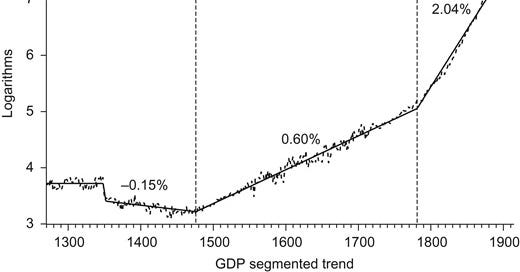MS CEO Satya Nadella and AI generated 10% economic growth.
“Let’s have that Industrial Revolution type of growth,” Nadella said.
Microsoft CEO Satya Nadella argued in an interview with Dwarkesh Patel that true AGI should be measured by economic growth rather than AI advancements alone. That may seem like a weird redefinition, but let's forget that for now.
Nadella says, “The real benchmark is the world GDP growing at 10%.” He draws a comparison from Industrial Revolution:
“When we say this is like the Industrial Revolution, let’s have that Industrial Revolution type of growth, That means to me, 10%, 7%, developed world, inflation-adjusted, growing at 5%. That’s the real marker. It can’t just be supply-side.”
That does not seem right. Per capita growth during industrial revolution was 2.66%1
Why 5% real GDP growth is unlikely.
From the Industrial Revolution today, technology and innovations contribute roughly 1 percentage point to economic growth. Labor and capital growth do the rest. That was true recently for China. The industrial revolution, mechanization of agriculture, railways, electricity, the internet, no technology nothing generated 10% growth. Labor and capital have contributed real growth above that 1% level.
It seems like Nadella is thinking microeconomics, and not realizing that macroeconomics does not work like that. In macroeconomics negative feedback loops dominate.
Baumol effect and cross elasticity of demand (XED)
XED is the effect of changes in the price of one good or the quantity of demand for another good. The baumol effect is one example of XED. If AI or robots increase productivity in one product or service, or part of it, it means that the work they do becomes cheaper relative to non-automated work.
The relative value of technological products and services becomes a smaller share economy. Agriculture was once 90% of the economy, now it’s 3% of the economy. Nutrition is plenty and cheap, but it does not contribute to the economy as large share as it used it.
It’s hard to see how a massive increase in objective value produced by technology, transfers into similar growth in GDP growth.
Growth Economists are very focused on AI, automation and their effects to growth, but it seems like nobody agrees with Nadella. That does not mean that AI is not increasing GDP. Acemoglu estimates ~0.5% total factor productivity growth and additional 0.93% long term GDP growth2 . That’s significant.
Six centuries of British economic growth: a time-series perspective, European Review of Economic History, Volume 21, Issue 2, May 2017, Pages 141–158, https://doi.org/10.1093/ereh/hew020
The Simple Macroeconomics of AI, Economic Policy, 39(120), 2024. Daron Acemoglu, August 2024



